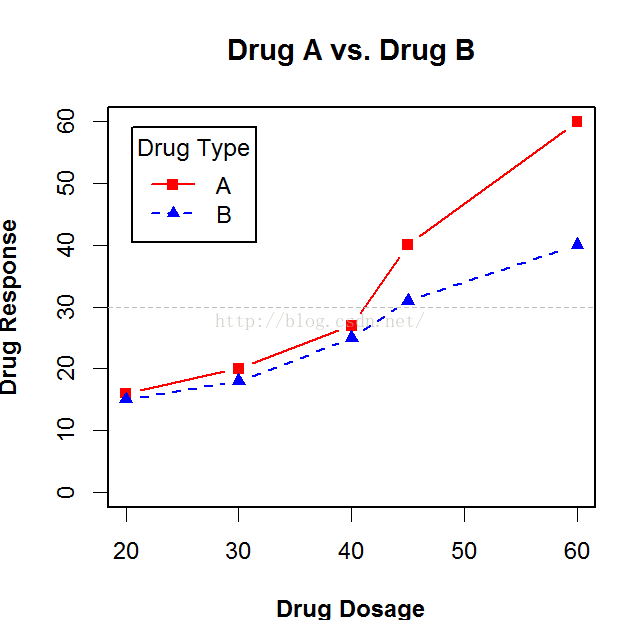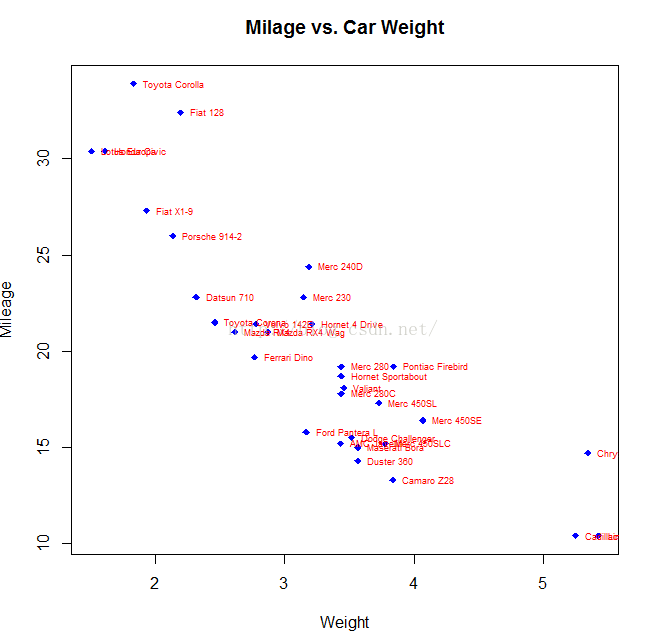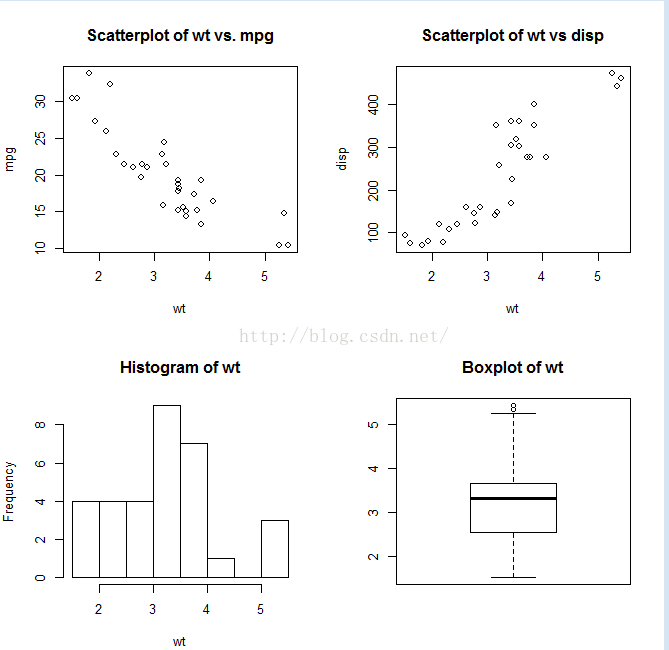R语言中基本图形的绘制
1、首先绘制一个简单的线性回归的例子
attach(mtcars)
plot(wt, mpg)
abline(lm(mpg ~ wt))
title("Regression of MPG on Weight")
detach(mtcars)
以下的例子主要针对下表进行绘制
dose <- c(20, 30, 40, 45, 60)
drugA <- c(16, 20, 27, 40, 60)
drugB <- c(15, 18, 25, 31, 40)
plot(dose, drugA, type = "b") dose是横坐标,drugA是纵坐标 type=b是折线图
图形参数的介绍
修改图形的参数可以使用函数par(operation=value,operation=value,。。。)
这种修改的作用范围直到会话结束
opar <- par(no.readonly = TRUE) 得到可修改的参数列表
par(lty = 2, pch = 17) 修改图形的参数列表
plot(dose, drugA, type = "b")
par(opar) 将参数列表还原
符号与线条
颜色属性
文本属性与字体属性
图形尺寸与边界尺寸
以下是一个完整的例子。
ose <- c(20, 30, 40, 45, 60)
drugA <- c(16, 20, 27, 40, 60)
drugB <- c(15, 18, 25, 31, 40)
opar <- par(no.readonly = TRUE)
par(pin = c(2, 3))
par(lwd = 2, cex = 1.5)
par(cex.axis = 0.75, font.axis = 3)
plot(dose, drugA, type = "b", pch = 19, lty = 2, col = "red")
plot(dose, drugB, type = "b", pch = 23, lty = 6, col = "blue",
bg = "green")
par(opar)
添加文本、自定义坐标轴,图例
plot(dose, drugA, type = "b", col = "red", lty = 2,
pch = 2, lwd = 2, main = "Clinical Trials for Drug A",
sub = "This is hypothetical data",
xlab = "Dosage", ylab = "Drug Response", xlim = c(0,
60),
ylim = c(0, 70))
使用标题函数title()
title(main="",sub="",xlab="",ylab="",col.main="",col.sub="",cex.main="",cex.sub="")
自定义坐标轴
axis()
x <- c(1:10)
y <- x
z <- 10/x
opar <- par(no.readonly = TRUE)
par(mar = c(5, 4, 4, 8) + 0.1)
plot(x, y, type = "b", pch = 21, col = "red", yaxt = "n",
lty = 3, ann = FALSE)
lines(x, z, type = "b", pch = 22, col = "blue", lty = 2)
axis(2, at = x, labels = x, col.axis = "red", las = 2)
axis(4, at = z, labels = round(z, digits = 2), col.axis =
"blue",
las = 2, cex.axis = 0.7, tck = -0.01)
mtext("y=1/x", side = 4, line = 3, cex.lab = 1, las = 2,
col = "blue")
title("An Example of Creative Axes", xlab = "X values",
ylab = "Y=X")
par(opar)
dose <- c(20, 30, 40, 45, 60)
drugA <- c(16, 20, 27, 40, 60)
drugB <- c(15, 18, 25, 31, 40)
opar <- par(no.readonly = TRUE)
par(lwd = 2, cex = 1.5, font.lab = 2)
plot(dose, drugA, type = "b", pch = 15, lty = 1, col = "red",
ylim = c(0, 60), main = "Drug A vs. Drug B", xlab ="Drug Dosage",
ylab = "Drug Response")
lines(dose, drugB, type = "b", pch = 17, lty = 2,
col = "blue")
abline(h = c(30), lwd = 1.5, lty = 2, col = "grey")
library(Hmisc)
minor.tick(nx = 3, ny = 3, tick.ratio = 0.5)
legend("topleft", inset = 0.05, title = "Drug Type",
c("A", "B"), lty = c(1, 2), pch = c(15, 17), col = c
("red", "blue"))
par(opar)
如何将坐标中点的信息显示在图上使用二个函数
text()mtext()
以下的例子是text()
attach(mtcars)
plot(wt, mpg, main = "Milage vs. Car Weight", xlab = "Weight",
ylab = "Mileage", pch = 18, col = "blue")
text(wt, mpg, row.names(mtcars), cex = 0.6, pos = 4,
col = "red")
detach(mtcars)
图形的组合实现
par(mfrow=(nrows,ncols))默认按列填充
attach(mtcars)
opar <- par(no.readonly = TRUE)
par(mfrow = c(2, 2))
plot(wt, mpg, main = "Scatterplot of wt vs. mpg")
plot(wt, disp, main = "Scatterplot of wt vs disp")
hist(wt, main = "Histogram of wt")
boxplot(wt, main = "Boxplot of wt")
par(opar)
detach(mtcars)
可以使用layout()函数控制图形的高度,以及位置
attach(mtcars)
layout(matrix(c(1, 1, 2, 3), 2, 2, byrow = TRUE),
widths = c(3, 1), heights = c(1, 2))
hist(wt)
hist(mpg)
hist(disp)
detach(mtcars)
opar <- par(no.readonly = TRUE)
par(fig = c(0, 0.8, 0, 0.8))
plot(mtcars$wt, mtcars$mpg, xlab = "Miles Per Gallon",
ylab = "Car Weight")
par(fig = c(0, 0.8, 0.55, 1), new = TRUE)
boxplot(mtcars$wt, horizontal = TRUE, axes = FALSE)
par(fig = c(0.65, 1, 0, 0.8), new = TRUE)
boxplot(mtcars$mpg, axes = FALSE)
mtext("Enhanced Scatterplot", side = 3, outer = TRUE,
line = -3)
par(opar)
















